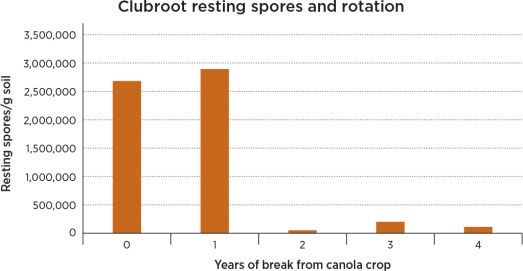Rotate crops for blackleg and clubroot management
Key practice: Increasing the number of years between
canola crops in the rotation reduces incidence and severity
of blackleg and clubroot in fields.
Key research: Kutcher, H.R., University of Saskatchewan, et al.
“Blackleg Disease of Canola Mitigated by Resistant Cultivars and Four-Year Crop Rotations in Western Canada.” Canadian Journal of Plant Pathology (2013). Peng, G., Agriculture and Agri-Food Canada (AAFC), et al. “Crop Rotation, Cultivar Resistance, and Fungicide/Biofungicides for Managing Clubroot (Plasmodiophora brassicae) on Canola.” Canadian Journal of Plant
Pathology (2014).
Research in Western Canada has identified significant risk of yield loss from blackleg and clubroot when canola is grown in short rotations. Crop insurance data shows that a one-year break between canola crops provides a clear yield advantage over back-to-back canola. However, longer rotations can improve the management of both of these diseases.
A one-year break between canola crops significantly reduces the carryover of the blackleg fungus on canola stubble, which reduces blackleg severity and the risk of yield loss. A two-year break between canola crops provides a further reduction, and a three-year break can effectively eliminate the yield loss risk from blackleg.
A longer break is also better for clubroot. Note that rotation does not cause clubroot, but short rotations can increase the disease once clubroot is present in a field. Effective management also requires use of clubroot-resistant varieties, limited soil movement and control of clubroot host weeds. Crop rotation is an important long-term management step to maintain effective-ness of the clubroot resistance gene on those fields infested with clubroot spores.
Randy Kutcher of the University of Saskatchewan et al published “Blackleg Disease of Canola Mitigated by Resistant Cultivars and Four-Year Crop Rotations in Western Canada.” This 10-year study, funded by SaskCanola, was to determine the implications of shorter rotations while considering cultivar and pesticide improvements made since the four-year rotation recommendation was established.
Canola rotations consisted of continuous canola, wheat-canola, wheat-pea-canola, wheat-pea-wheat-canola and wheat-flax-wheat-canola. Both blackleg-resistant hybrid (HYB) and blackleg-susceptible open-pollinated (OP) cultivars were tested.
With the OP cultivar, blackleg incidence doubled (62 percent) with continuous canola cropping when compared to the four-year rotation (31 percent). Blackleg severity was also 2.6 times higher with continuous canola compared to the four-year rotation.

Similar incidence and severity results were seen with the resistant hybrid cultivar, but the extent of the disease was expectedly reduced. Incidence was 3.3 times greater in continuous canola production (24 percent) and more than double in the two-year rotation (15 percent) compared to the four-year rotation (seven percent).
Although fungicides were effective at reducing blackleg incidence for both cultivars, the magnitude of the reduction in incidence and severity was greater for the OP than the HYB.
Kutcher concluded, “Yield data would suggest that progress was made in genetic resistance to blackleg in the HYB cultivar, but this has not overcome the need for at least three-year, if not four-year, rotations to achieve optimum canola yield
and to reduce the risk of resistance breakdown of current canola cultivars.”
Another paper, “Crop Rotation, Cultivar Resistance, and Fungicide/Biofungicides for Managing Clubroot (Plasmodiophora brassicae) on Canola,” published by Gary Peng of AAFC et al, is an analysis of recent canola research in Canada to examine the effect of crop rotation, cultivar resistance and biofungicide or fungicide treatments against clubroot.
Three field studies were also used to answer questions about potential synergy between cultivar resistance and biofungicides; biofungicide seed dressing and crop rotation; and the interaction of resistant cultivars and crop rotation.
Based on the results of this research, use of synthetic fungicides
or biofungicides could not be deemed commercially feasible for managing clubroot on canola until greater efficacy is achieved through development of improved formulations.
“At this time, a resistant canola cultivar used in conjunction with a three-year crop rotation is likely to be the most effective and practical strategy for clubroot disease management,” Peng concluded. “This practice reduces the inoculum loads in the field and allows the resistant cultivar to reach maximum yield potential.”




